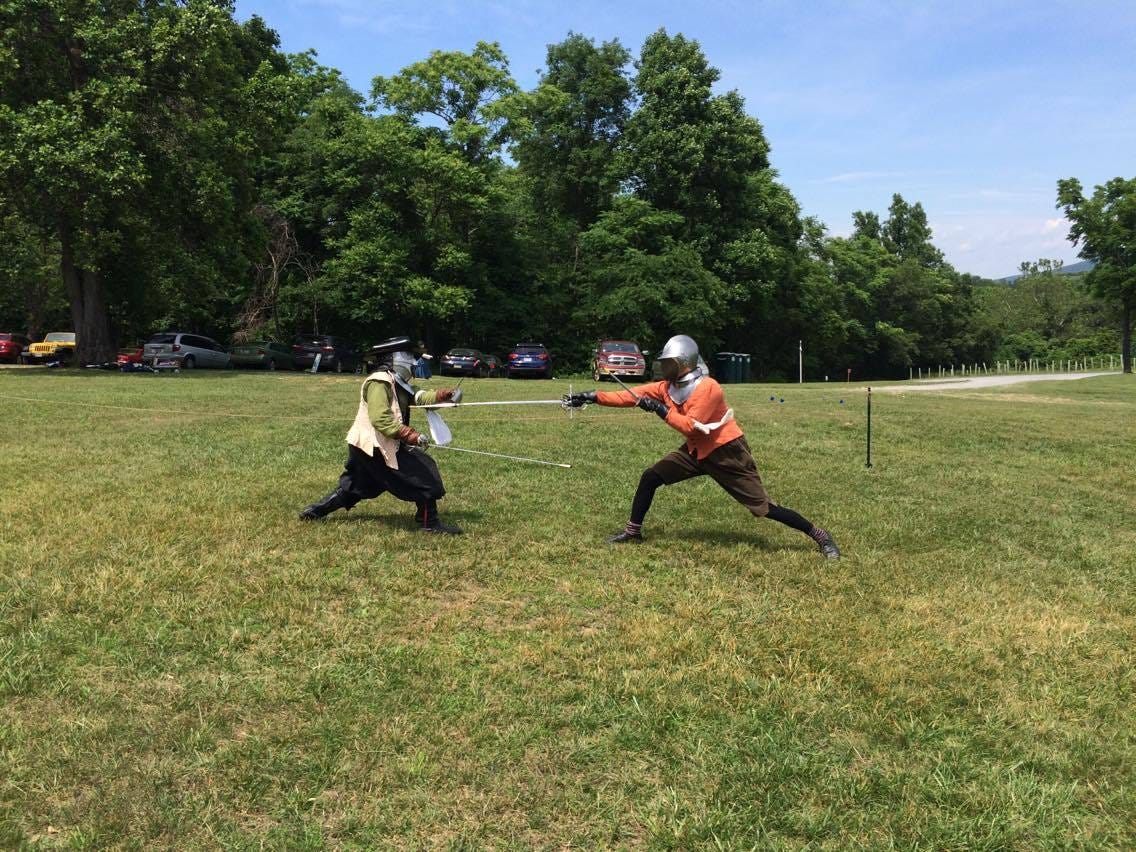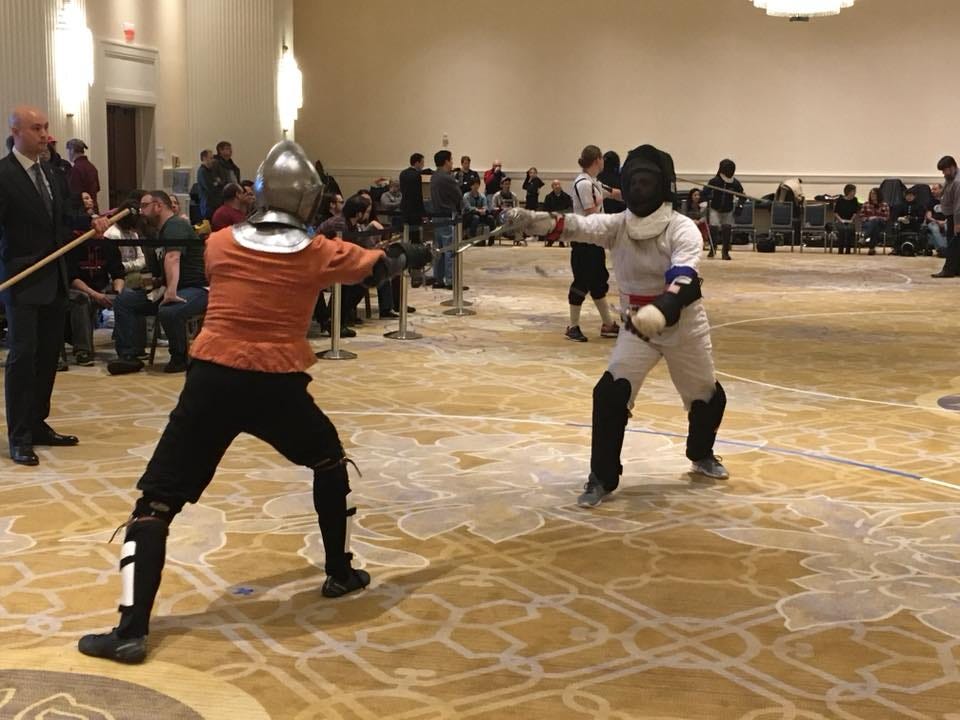When I began designing Lord Baltimore’s Challenge several years ago, I knew I wanted to find a way to encourage the type of fencing I myself enjoyed, and that meant creating a ruleset that brought out those features. At some point in that planning I had to come to a decision on how the winner of each bout would be determined. And that discussion is what this issue is all about.
I will write more later about my planning and thought process that went into designing LBC and its tournaments, but this issue is a discussion about the pros and cons of self-calling bouts, judged bouts, and ideas in-between.
—Weekend Seminars!—
Let me take a pause here to say clearly that if any of you feel you and/or your friends would benefit from a weekend seminar on the Northern Italian rapier system that you’ve been reading all about in this newsletter so far, or possibly the Dardi school of spada da lato which I plan to get to in future issues, please do contact me or leave a note in the comments. I’m happy to oblige if the details can be worked out. Passing this stuff on and watching students grow their skills and understanding is what I really enjoy most.
Making a ruleset - what type of tournament?
As soon as we start adding rules to an activity, we are eliminating things we don’t want to see and encouraging things that we do want. This is true of all arts. Nothing that has a ruleset is a “true” or “real” depiction of a martial exchange. But you can choose things you want to bring out and encourage them through your choices.
I have designed fencing tournaments that employ: a panel of judges watching from the side; judges and a ring director that actively engage in the bout; self-calling hits against yourself; and a hand of cards to determine who wins.
Each has its positive and negative issues. But for my purposes I have landed on what I think is the best overall method for a skill-based tournament.
A panel of judges
If you want to encourage fencers to stay within a specific system, or to act a certain way in the fight, one way to do that is to use a panel of judges who observe the bouts and make notes that lead to a score.
This is the method you usually see in several of the Olympic games. It’s also common with some fully armored martial tournaments. In the SCA we often see it attached to “by the book” type tournaments where the point is to highlight the application of historically documentable techniques.
When you design a tournament with judging you also decide on what earns points, what doesn’t earn points, and what leads to cautions or even points deductions. There are a few different ways to do this. You can do it by subtraction - set a maximum score in the case that everything is done perfectly and then imperfect actions earn reductions. You can do it by addition - some things earn points, and as the judges see those things, they increase their score. The judges can also just watch and when the bout is over (by whatever pre-set conditions are met) they can decide which fencer met their requirements the best.
The first C&T tournament in the SCA that I’m aware of was done this way back in the early ‘00s. We had to get permission to have a tournament at all - back then, due to issues we won’t get into here, skill-based tournaments were not allowed using C&T weapons and rules. So what I designed instead was a tournament created to highlight the techniques of the sidesword, and to encourage fun, safe, and honorable fights. We were still promoting the whole idea of studying sidesword as a historical art at the time, and so the panel was looking for who represented the style the best.
This method can be very subjective - sometimes on purpose, when the goal is to promote a fun or honorable fight, or when it’s just to create a spectacle for an audience.
When it’s attempting to be objective, though, this method relies heavily on expert judges who understand well what they’re seeing, and as I’ll discuss below, judges like these can be very hard to come by in our arts.
Self-called bouts
Self-called fights are exactly what they sound like. Each fencer calls their own hits or other actions agains them based on the rules or conventions laid out in the organization or tournament.
While this seems like a problem waiting to happen in a competitive atmosphere, and it certainly can be and has been abused, it actually works surprisingly well in the right contexts.
In the early days of my fencing experience in the SCA I participated in a couple of tournaments that did bring out the worst of self-called bouts. There were a few people who would rather be seen as the winner of the fights than actually fairly win the fight, and that really got under my skin.
But then I went and watched an olympic-style tournament at a nearby university and was amazed at the things I was seeing in this electronically-scored tournament. The fencing I saw was optimized to get the electronic buzzer to go off, and that was all. I saw fencers lunge at their opponent while turning their head to see if the light flashed for them. I saw terrible sportsmanship. I saw poor swordplay that dismissed defense almost entirely. I saw many things that put my own experiences into a new perspective. And I realized that those few fencers I had been frustrated with actually served to highlight the dozens of other fencers I fought with weekly with whom I never had an issue.
Across the SCA there’s a social capital involved in the combat, as there has been throughout the history of fencing as a sport.1 Someone who would choose to win bouts through bending or ignoring the rules, or by using their opponent’s honor against them will quickly gain a reputation for doing so, and that reputation will most often follow that person around a long time. One saying I’ve heard is that it takes years to build up a good reputation for blow calling and playing well with others. But it only takes a few tournaments where you come off like an asshole to trash whatever good reputation you’d built up. But the way I try to get it across to my students is: Do you want to just be seen as the winner? Or do you want to win because you’re the best fencer that day?
Because in a self-called fencing system that relies on personal honor,2 you can win fights by just refusing to play by the agreed-upon conventions. And it surely happens in SCA fighting.
But then, I’ve also seen this happen in judged tournaments.
The subjective nature of adjudicating hits has opened up substantial opportunities for cheating and subterfuge from both fencers and fencing officials alike.3
Active judging
What I call active judging is what most in HEMA know as judged tournaments, though there are variations here as well.
In some judged tournaments there is a ring director who has the final say over what happened in the ring. In others, the ring director can’t overrule two or more judges who see the same action that resulted in a hit. And there are other tweaks I’ve seen as well.
When done well, this is generally a good way to have objective eyes on the actions. But again - it relies on experienced judges and ring directors.
I fought in my first judged tournament at the International Swordfighting and Martial Arts Convention (ISMAC) in 2004 or 2005. (I believe ISMAC eventually became CombatCon)
After a decade or so of fighting in an exclusively self-calling system, it was interesting at ISMAC to have to rely on someone else calling my blows. In the end they did a very good job, but they still missed a few touches. But nothing in the rules kept us from calling our own blows, so when the judges didn’t see something that I felt, I let them know, as did a few others that day. (Yes, that means I gave up points against myself that I didn’t have to give up. If you’re confused by this, go back and read the part where I teach my students that part of the goal is to actually win against their opponent, not just to “be seen” as winning.)
The next year at the same ISMAC tournament, the principal judge in his opening remarks commented that the previous year’s tournament was the most honorable fencing display he’d seen, and hoped that we continue the tradition. Which we did.
Under the ISMAC ruleset, each fight had five judges - one on each corner of the stage we were fighting on, and a lead judge floating and running the bouts (what we often now call ring directors). It’s important for this discussion to note, though, that all five judges were certified maestros of classical fencing pedagogy each with decades of fencing experience.
And therein lay the problem with HEMA judged tournaments. Good ring directors are good not because they can see the actions as they happen. They’re good because they have years of experience in that weapon style (or a related one) and can anticipate actions and deconstruct the results of the fight. When they call a halt to the fight because they or one of their judges saw a hit, they can then reconstruct the actions based on their experience with the weapons through the lens of what just unfolded before them. Yes, they can see a lot of the actions, but when they had a bad angle, or there was a flurry of movement, they are able to reconstruct what happened with a high degree of accuracy.
A good judge is also good because of a similar experience with the weapons. When the actions of an exchange are in progress a good judge is able to follow them and even slightly anticipate what might happen from one moment to the next.
The large majority of HEMA judges, though, do not have this level of experience in rapier or C&T combat. I’ve participated in some HEMA rapier tournaments where the judges were pulled from other sword styles that weren’t competing at the time. Several have apologized to me for their inability to understand what was going on during the combat. “I’ve never used a rapier before” was said to me in variations by several rapier judges at HEMA events. This is an accepted norm at many HEMA tournaments.
I’ve definitely lost HEMA bouts because the judges didn’t see what happened but felt they had to make some pronouncement. I even pezzed4 one opponent twice in the mask during a fight and the two judges missed it. The ring director saw it, but didn’t think the rules would let him overrule his judges. And I have seen well-known fencers miss their opponent, but recover back with a fist pump or other outward show of success which triggered judges to react and give that fencer points, even thought hey clearly didn’t see what happened.
Judged tournaments like these do not remove the gamesmanship from the fencing, and in fact with inexperienced judges it can make it even more prevalent. The desire for tournaments has far outstripped HEMA’s ability to provide skilled judges, and the desire to create larger and better-attended tournaments exacerbates the problem.
Strengths and weaknesses
Any way you might want to determine the winner of a fencing match has its pros and cons. In 1933, for instance, in order to improve the certainty of the hit and reduce the bias of judges, the épée (one of the three modern fencing weapons) become electrified at FIE (International Fencing Federation) and Olympic competitions. But some argue that far from improving the art of fencing, mechanical scoring has instead placed the art in serious jeopardy of becoming lost.5
To be continued…
In part 2 we’ll look at a way to combine the best parts of judged and self-call tournaments that has worked very well for Lord Baltimore’s Challenge.
Next up:
Breaking down Capoferro’s plate 8 - the practice (Paid subscribers)
Deciding who wins the bout - part 2 (All subscribers)
Sullins, John, MA, PhD. “A Hit, A Very Palpable Hit: Electronic Scoring and the Loss of the Art of Fencing.” Presentation for the Society for Philosophy and Technology’s XIII Conference, https://www.whitman.edu/fencing/Articles/Palpable.doc. (“These fencers would, for the most part, exclaim loudly, “touché”, or their national equivalent, whenever hit. Not to do so would jeopardize one’s personal reputation for honesty and that repute was more important then wining at a game.”).
Shilling, Erik. “The Long History behind Fencers’ Hit-Detecting Electrified Gear.” Atlas Obscura, 11 Aug. 2016, www.atlasobscura.com/articles/the-long-history-behind-fencers-hitdetecting-electrified-gear. (“In the sport’s early years all it had to rely on weren’t wounds but each fencer’s honor.”); Also see, Sullins, “A Hit, A Very Palpable Hit,” https://www.whitman.edu/fencing/Articles/Palpable.doc, (“[F]encing was able to flourish as a sport reaching an apex of popularity in Europe just prior to World War I. It did so by appealing to the fencer’s sense of personal honor.”).
Sullins, “A Hit, A Very Palpable Hit,” Page 2, https://www.whitman.edu/fencing/Articles/Palpable.doc.
“Pezzed” is a colloquial term used in some fencing systems to describe when one fencer has hit another in the mask such that the mask tilts back, calling to mind a Pez dispenser.
See generally, Sullins, A Hit, A Very Palpable Hit, https://www.whitman.edu/fencing/Articles/Palpable.doc.









This is a very good reflection on the perennial problem in fencing. Rules set various constraints on the fencers and then they will naturally evolve different techniques to maximize their results against these constraints. So rules writers need to determine what kind of event they are trying to create, try to write rules that promote that but then they really need to red team the rules and find people to help them find ways to stay in the letter of the rules but break the spirit of the rules. This is so painful and this process has made me give up numerous times. I then fall back into the safety of just fencing with people who are interested in the art over winning and that is much more fun. However, it does not allow us to be challenged by competitors who might help us grow in our capabilities. I am looking forward to seeing what you create!
As a bitter-sweet perspective, we can imagine that not all thrusts and cuts are sufficient to stop a real duel, not even hits to the head. So one can imagine the judges missing a point to represent the intervention of Lady Chance when it comes to the impact a hit has on the opponent.
Yea... I wouldn't feel happy with loosing points in a tournament as you described. My rationalisation is the best way I can think to accept such outcomes and move on. ;)